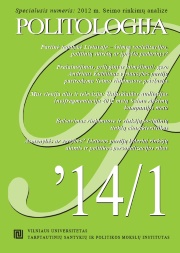MUS VIENIJA ALUS IR TELEVIZIJA: ŽINIASKLAIDOS AUDITORIJOS (NE)FRAGMENTACIJA 2012 METŲ SEIMO RINKIMŲ KAMPANIJOS METU
(NON)FRAGMENTATION OF MEDIA AUDIENCE IN LITHUANIA DURING THE 2012 PARLIAMENT ELECTION CAMPAIGN
Author(s): Laima NevinskaitėSubject(s): Media studies
Published by: Vilniaus universiteto leidykla & VU Tarptautinių santykių ir politikos mokslų institutas
Summary/Abstract: The aim of the article is to analyse the extent of media audience fragmentation in Lithuania during the 2012 Parliament election campaign and to define which media channels are best able to unify the audience. Increasing fragmentation of media audience raises concerns about its possible effects on democracy. The concerns are that different fragments of the audience will not hear each other and will not talk to each other, which poses a threat to the unity of political community and hampers a constructive discussion on the common matters and consensus based common decisions. However, audience fragmentation is still under-researched empirically. The article uses data from a representative survey conducted after the 2012 Parliamentary elections and asks questions on the pre-election period. Methodologically, the analysis is based on the analysis of audience duplication of different media outlets, as well as network analysis to visualise the duplication of audiences. The article analyses data on the use of different news-oriented media outlets with the largest audience share from all media branches (television, radio, daily newspapers, and internet portals) and calculations of their audience duplication. Although there is no firm point of comparison to assess the extent of fragmentation (e.g. historical data), the data show a considerable overlap of media audiences. Most probably, the fragmentation would be larger in the periphery of the media system, but the analysis of the main media shows a considerable overlap. Therefore, the main conclusion is made that the Lithuanian media audience is not (yet) fragmented. The media that unites the biggest share of the audience is television. Although it is positive that it is still able to connect different fragments, in terms of content it is negative that during the pre-election period it had comparatively little amount of information on election campaign, parties and candidates. However, a very popular media outlet competing with television was the biggest internet news portal, which had a huge amount of information on elections. The article also includes analysis of agenda fragmentation in the audience which revealed the tendency of internet users to have a more fragmented agenda than the part of the audience that doesn’t use the internet. However, in comparison to similar Norwegian data on agenda fragmentation, the agenda of the Lithuanian audience could not be regarded as fragmented. In the future, the analysis of audience fragmentation will be dependent on the collection of comparable data, since it would provide data for comparison and assessing the trends of fragmentation in time. These data would also help to solve some methodological issues that are also discussed in the article, like choice of criteria for assessment and having a point of comparison.
Journal: Politologija
- Issue Year: 2014
- Issue No: 1 (73)
- Page Range: 67-97
- Page Count: 31
- Language: Lithuanian

